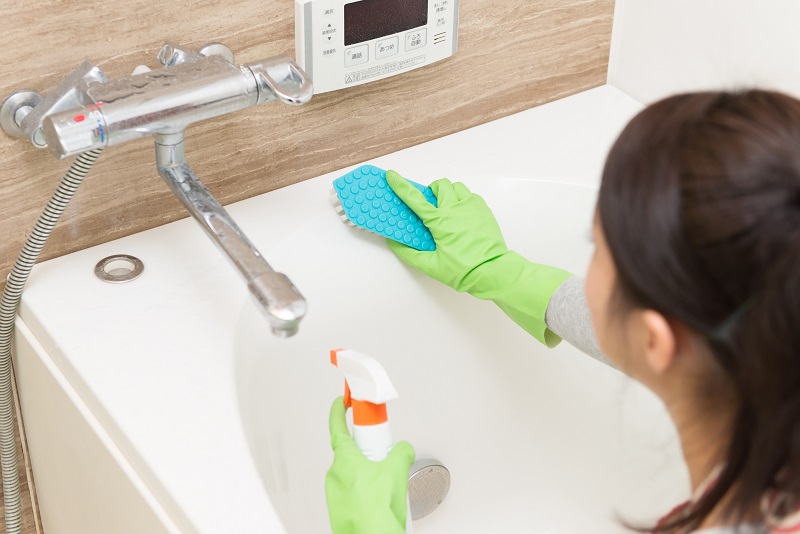White flakes floating in a hot tub or pool are not only unsightly—they are an indication of mold. White water mold is a contaminant that should be eliminated, pronto, because it is a nuisance that can cause problems. Here’s how to remove the mold from the hot tub and pool.
What is white water mold?
White water mold is a mucous-like substance that is commonly found in moisture-rich spaces, like pools, hot tubs, and pipes. These biofilms are neither oomycote or chytridomycota (organisms that thrive in water). Rather, white water mold is a type of fungal growth.
Resembling shredded white facial tissue floating along the water’s surface, white water mold is a common occurrence in swimming pools and hot tubs. The white water mold appears most often in pools and hot tubs that are improperly cleaned; irregular chlorine levels can also cause the mold.
Is white water mold harmful?
When exposed to small amounts, people using the pool or hot tub are not typically subject to ill health. However frequent exposure to the mold can trigger symptoms in people suffering from mold allergies. Large quantities of white water mold also serve as irritants in susceptible individuals.
Furthermore, white water mold often starts in a pool’s filter lines. The mold grows to be heavy by the time the colonies are visible. As a result of the growth, the white water mold can clog or damage equipment. Other problems can occur, such as murky or green pool water.
What causes white water mold?
Understanding the origins of white water mold is a first step in helping property owners prevent a reoccurrence. Hot tubs may be initially exposed to the mold during the manufacturing process. Homeowners, too, can contribute to white water mold growth at home.
For instance, when a homeowner drains the hot tub and refills it a few days later, white water mold can take hold. Or, using a moldy garden hose to fill a hot tub introduces white water mold. Leaving the hot tub lid open allows spores to infiltrate the spa water.
Homeowners who fail to regularly use sanitizers, like chlorine or bromine, to clean the hot tub will allow the spores to proliferate. The mold colonies may not be apparent for six to eight weeks. By the time the spores are visible, the infestation will have ballooned into a major problem.
How is white water mold removed from a hot tub?
Decontamination of the spa is the first step to eradicating white water mold.
- Chlorinate the water with granular bromine or chlorine for 72 hours. For every 100 gallons of spa water, add 2.5 ounces of chlorine. Adding additional chlorine is optional.
- Next, distribute the chlorinated water throughout the plumbing system: Open the valves, waterfalls, jets, aerators, and water features to allow the chlorinated water to pass through. Force the water through the drain, as well, since mold contaminants are likely growing there.
- Once the 72 hours of chlorination has passed, clean the filter and plumbing.
Upon draining the spa and installing a clean filter, refill the hot tub. Be sure to turn on the jets when refilling. If the mold flakes appear from the plumbing, repeat the draining and refilling process.
How is white water mold eliminated from the pool?
When white water mold appears on the surface of pool water, the fungus has already contaminated the pipes and infiltration system.
- Rinse the cartridge filter with a hose.
- Use a test strip to measure the pH level of the water. Ideally, the pH level should be between 7.2 and 7.6.
- Similar to chlorinating a spa, shock the pool with chlorine. For every 10,000 gallons of pool water, add three to four pounds of shock.
- Using a brush with appropriate bristles, brush the pool around the return jets, ladders, pool skimmer, and other places mold inhabits.
- Once the first round of brushing is complete, run the pump for 24 hours. The filter will catch the mold.
- Brush the pool a second time.
- Manually vacuum the pool.
- Run the garden hose for a few minutes to eliminate any mold growing inside, then top up the water.
Perform a final reclean of the filter and a retest and balance of the water. The pool will be free from white water mold at this point. Prevent its return by keeping the pool clean. Follow a maintenance schedule, which includes running the filtration system, brushing, and cleaning with sanitizers.
Professional Mold Remediation
While owning a hot tub or pool is a luxury, maintaining either is a responsibility. Mold seizes moisture-rich spaces, like pools and hot tubs, but can infest other parts of the home.
When mold makes its entrance, consult the mold cleanup pros at ServiceMaster of San Francisco/San Mateo.
Our IICRC certified crews are experienced in eliminating mold growth from all types of residential and commercial properties. Whether your mold problem is minor or catastrophic, our mold remediation technicians will eliminate the colonies with speed, efficiency, and professionalism.
We are equipped with advanced mold restoration tools, such as cutting-edge floor mat systems and hydroxyl technology. Our powerful dehumidifiers and air movers rapidly remove all excess moisture.
Restoration services, like content cleaning, pack-out services, and carpet and upholstery cleaning are included.
ServiceMaster of San Francisco/San Mateo provides IICRC-certified mold removal services.
Our mold specialists are available 24/7 at (800) 439-8833 in the San Francisco, San Mateo, CA and Palo Alto, CA areas to respond to cases of mold remediation.
Sources:
https://moldblogger.com/how-to-deal-with-white-water-mold/
https://spamarvel.com/blog/white-water-mold-hot-tub/
https://poolonomics.com/white-water-mold-in-pool/
https://www.homequestionsanswered.com/what-is-water-mold.htm
https://poolresearch.com/white-water-mold-pink-slime/



